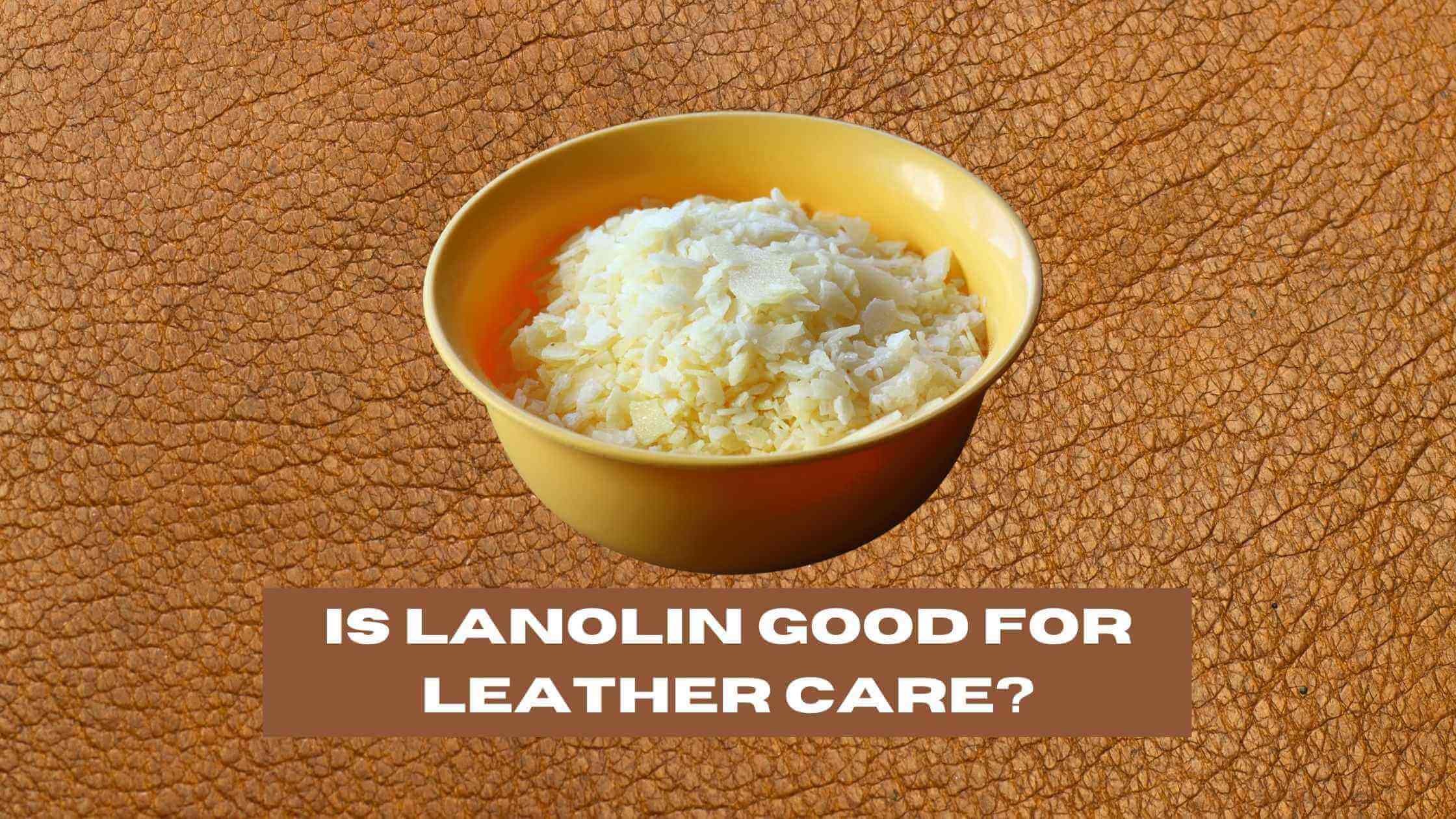Lanolin, a natural waxy substance, has been a topic of discussion among leather enthusiasts for its potential benefits in leather care. Derived from the sebaceous glands of sheep, lanolin is commonly used in various personal care products, and its properties have garnered attention for its application in leather goods. But is lanolin good for leather?
Lanolin is good for leather care due to its natural emollient properties, which soften and condition the leather, preventing drying and cracking. However, it may not be suitable for all types of leather, and improper application can lead to issues such as discoloration and stickiness.
Understanding Lanolin
When it comes to leather care, lanolin is a popular ingredient found in many leather conditioners. This section examines lanolin’s composition and extraction, as well as its properties and how they make it a beneficial addition to leather care products.
Composition and Extraction
Lanolin, also known as wool grease, is a waxy substance derived from the wool of sheared sheep. The extraction process involves washing the wool with an alkaline solution and then separating the lanolin from the wash water through a centrifuge. The lanolin found in leather care products is typically anhydrous, meaning it contains little to no water.
Properties of Lanolin
Lanolin has several properties that make it an ideal ingredient for leather conditioners. Its waxy and sticky texture helps it adhere to the leather’s surface, while its emollient properties aid in softening and moisturizing the leather.
Lanolin closely replicates the natural oils found in animal skin and is instrumental in preserving the leather’s pliability and preventing it from drying out or cracking. Additionally, it exhibits water-repellent, anti-fungal, and antibacterial properties, making it an effective option for maintaining your leather items in top shape.
Using Lanolin as a Leather Conditioner
Applying lanolin to your leather goods can help keep them clean and protected. To use lanolin as a leather conditioner, follow these steps:
- Ensure the leather item is clean and dry. If necessary, use a leather cleaner or mild soap with a damp cloth to clean the surface, then allow it to dry completely.
- Apply a small amount of lanolin cream or wax to a clean, soft cloth, then gently rub it onto the leather surface in a circular motion. Be sure to apply the product evenly and avoid using too much, as it may darken the leather or leave a greasy residue.
- Allow the lanolin to soak into the leather for at least 24 hours. This will allow the leather to absorb and retain the moisture effectively.
- After the lanolin has soaked into the leather, use another clean, dry cloth to buff away any excess product and ensure an even finish.
Using lanolin as a leather conditioner can help prolong the life of your leather items, keeping them supple and in good condition for many years.
However, it is essential to test the product on a small, inconspicuous area first, as some leathers may experience discoloration or altered textures when treated with lanolin. Also, be aware that lanolin may soften the leather more than some other leather conditioners, so consider this when applying the product to your leather items.
Pros and Cons of Lanolin for Leather
Lanolin, a waxy substance derived from sheared sheep’s wool, is often used as a leather conditioner due to its natural emollient properties. This section will explore the pros and cons of using lanolin for leather care.
Lanolin Pros
- A natural product that replicates animal skin oils
- Softens and conditions leather without damage
- It prevents drying out and developing cracks due to waxy and greasy texture prolonging your leather item’s life.
- Water-repellent
- Anti-fungal
- Antibacterial
Lanolin Cons
- Improper application can lead to issues
- Discoloration
- Stickiness
- Undesirable texture on leather surface
- Not suitable for all types of leather
- Check care instructions for specific leather item
- Use specially designed leather cleaner or conditioner if recommended
Reasons Why Lanolin is Good For Leather
In this section, we will discuss the reasons why lanolin is good for leather, including its ability to restore leather, act as a natural moisturizer, preserve leather color, prevent stiffness, reduce friction, and provide water resistance.
Restores Leather
One of the key benefits of using lanolin on leather is its ability to restore and maintain the original quality of the leather. This is particularly useful for older leather items that may have become stiff or inflexible due to lack of care. As a natural emollient, lanolin helps in keeping the leather’s texture soft and pliable, preventing any further cracking and splitting of the material.
Natural Moisturizer
A powerful yet natural moisturizer that is well-suited to leather care. The waxy substance forms a protective layer on the leather’s surface that locks in moisture, preventing it from drying out and ensuring its suppleness. Moreover, lanolin is gentle and safe for leather as it does not contain any harmful chemicals that could degrade the material.
Preserves Leather Color
Another advantage of using lanolin on leather is its ability to preserve and maintain the leather’s original color. By forming a protective barrier, lanolin can help prevent discoloration and fading caused by exposure to sunlight and other environmental factors. This helps keep your leather goods looking new and vibrant for a longer period of time.
Prevents Stiffness
Leather items can become stiff and uncomfortable if not properly conditioned and moisturized. Lanolin, with its unique emollient properties, keeps the leather soft and flexible by retaining its natural oils. This prevents stiffness and ensures that your leather goods remain comfortable and easy to use.
Reduces Friction
Lanolin also aids in reducing friction between leather surfaces by creating a smooth, protective barrier. As a result, it prevents wear and tear on high-quality leather items such as jackets, belts, gloves, and seats, ensuring their longevity and top shape.
Water Resistance
Lastly, it offers a degree of water resistance to leather items by forming a protective layer that repels water and moisture. This feature is especially beneficial for leather goods exposed to wet environments, helping them to last longer and maintain their quality over time.
Alternatives to Lanolin
While lanolin is known for its ability to soften and condition leather, there are alternative products available that serve a similar purpose. These alternatives can provide different benefits for your leather items, depending on their specific needs and requirements.
One popular alternative to lanolin is leather oil. Leather oil, either natural or synthetic, can moisturize and condition leather fibers, keeping them pliable and durable. Common oils used for leather conditioning include mink oil, neatsfoot oil, and coconut oil. These oils help to restore the natural oils in leather, preventing it from drying, cracking, and splitting.
Another option for leather care is using a high-quality leather balm or conditioner. Leather conditioners are typically creams or lotions that contain various moisturizing ingredients, like natural oils and waxes. These products can be rubbed onto the surface of leather items to improve their texture and appearance while also protecting them from environmental factors.
In addition to oils and conditioners, leather wax is another alternative that can be used to care for leather goods. Leather wax, such as beeswax, can provide a waterproof layer on the surface of leather items, keeping them clean and protected.
For preserving your leather items’ original color and preventing discoloration, you may want to consider using a leather cleaner before applying any conditioner or oil. Leather cleaners are designed to remove dirt and grime from the surface of leather goods, preparing them for further treatment like conditioning or waxing.
When choosing an alternative to lanolin for leather care, it’s essential to consider the specific needs of your leather items. This may include factors such as the item’s age, material, or exposure to environmental conditions.
Ultimately, proper leather care involves a combination of cleaning, conditioning, and protecting the items to ensure a long-lasting and attractive appearance. By using lanolin as a natural conditioner and following appropriate leather care practice, you can efficiently maintain the condition, texture, and resilience of your cherished leather goods.

